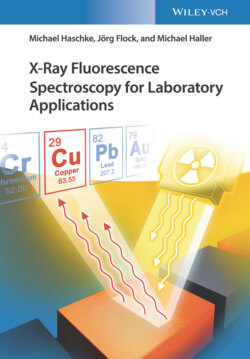Читать книгу X-Ray Fluorescence Spectroscopy for Laboratory Applications - Michael Haschke, Jörg Flock - Страница 14
2.2.2 Intensity of the Characteristic Radiation
ОглавлениеThe intensity of the characteristic radiation is determined by the number and type of the atoms in the excited volume; in other words, the intensity depends on their mass fraction w. It is further influenced by the intensity I0 of the primary radiation. The photo-absorption coefficient τ(E) describes the probability for the excitation of an atom by X-rays with energy E. If an inner electron shell is ionized, the transition from an outer electron shell is described by the transition probability p. For shells that are close together, p has the greatest value; therefore, the α-lines are the most intense within a series. For energy levels with a larger difference the transition probabilities are smaller, i.e. the intensities of the β-lines are correspondingly lower; however, their energies are higher. Special electron transitions can be excluded as a result of quantum selection rules; for these transitions, the transition probabilities are p = 0. For the main electron transitions, the labels of the corresponding X-ray lines are shown in Figure 2.3.
Figure 2.3 Electron transitions with the corresponding line names.
The approximate intensity ratios within a series as well as between the main lines of the different series (dependent on the excitation conditions) are shown in Table 2.1.
Table 2.1 Approximate relative line intensities of main X-ray lines.
| K-series | L-series | M-series | ||||||
|---|---|---|---|---|---|---|---|---|
| 100 | Approx. 5–10 | Approx. 1 | ||||||
| Kα1 | K–L3 | 100 | Lα1 | L3–M5 | 100 | Mα1 | M5–N7 | 100 |
| Kα2 | K–L2 | 50 | Lβ1 | L2–M4 | 50 | Mα2 | M5–N6 | 100 |
| Kα1,2 | K–L23 | 150 | Lβ2 | L3–N5 | 12 | Mβ | M4–N6 | 52 |
| Kβ1,3 | K–M2,3 | 15 | Lγ1 | L2–N4 | 6 | Mγ | M3–N5 | 5 |
| Kβ2,4 | K–N2,3 | 3 | Ll | L3–M1 | 5 | |||
| Lβ3 | L1–M3 | 10 | ||||||
| Lβ4 | L1–M2 | 7 | ||||||
| Lη | L2–M1 | 5 |
After an electron transition, the released energy is emitted. This is possible by the emission of characteristic radiation, which is due to the large energy differences of the involved electron levels in the range of X-ray radiation. Another possibility is the transfer of the energy to an outer electron of the atom under consideration and its emission. This process is called Auger effect. The probability for the emission of an X-ray photon again depends on the atomic number and is called fluorescence yield ωfluo. This probability is shown in Figure 2.4; more precise values for the fluorescence yield of the individual elements can be taken from Table A.11. Since an ionized atom always goes into the stable basic state,
Figure 2.4 Fluorescence yield as a function of the atomic number.
The relation shows that the fluorescence yields are very small for elements with low atomic numbers. Most of the atoms then emit the energy released by the transition to the ground state as Auger electron and only very few as X-ray photons. This is the main reason for the low sensitivity of X-ray spectrometry for light elements. For higher radiation energies, the fluorescence yield increases significantly.
